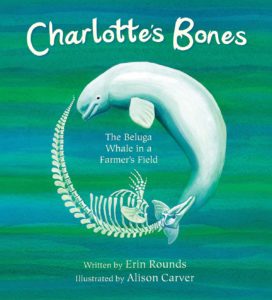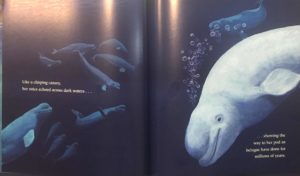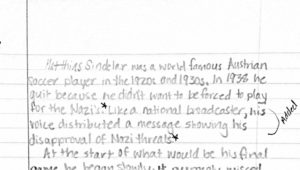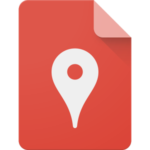Why I Picked It Up:
I LOVE the cover! There is so much to discuss. The imagery of the circle of life is beautiful and a little apocalyptic. And of course, if you know me at all you know I have a thing for marine life. So the book was placed in my Amazon cart.
Why I Finished It:
Truth: I finished it three times! I did a cold read the first time. It was sad and beautiful. It gave spirit to Charlotte, a beluga whale that got trapped in a lake in Vermont. The remains of Charlotte were discovered thousands of years later. Then I read the backmatter in the book. Here I learned more about beluga whales, how the whale made it to Vermont, and information about the actual discovery. So I reread the story with new knowledge. This helped me uncover the wonderment of the actual events while admiring the fictional aspects. Finally, I took a few days and let the story stew, and then I reread it again.
Who I Would Give It To:
The obvious choice would be science teachers. In addition, it really is an exciting story. It is probably best for grade 3 and up, although, I have known some younger kids who would enjoy this story as well.
Integration Ideas:
Writers’ Workshop: Writing process, expository writing, and research
I always like to research the authors of books I enjoy. What came up when I researched Erin Rounds was AMAZE-ING! She’s a teacher (my heart is happy) and the idea for writing this book struck her when her students were bored on a field trip to a museum. There, Rounds read the story about the whale’s remains being found in Vermont and thought it would make a great children’s book! She was right, however, she was rejected by publishers many times over the course of years before it was published! What a great lesson for the kids! Check out the story here. I think the big takeaways from the story of Charlotte’s Bones and Erin Rounds:
- Pay attention to the world around you – stories are everywhere.
- Rejection is a part of life and persistence pays off.
As teachers of Writers’ Workshop are we not always preaching these ideas? Thank you Erin Rounds. After reading this story aloud to the students, possibly three times as I did, use it as a mentor text for writing. Read aloud the article on the author. Talk with the students about what they take away from her story. Ask students where we might find stories in our own lives and make a list. Some possibilities might be the news, television shows, Facebook, internet, overheard stories, etc. Next, challenge the students to spend a week paying attention to stories that are around them. Over the course of the week, discuss the stories they are collecting. By discussing findings throughout the week, the activity is staying fresh on the students’ minds and keeping them motivated.
At the end of the week, have students choose one of their stories to develop. They will need to research their topic a little first. Check out our last post on refining research.
Once they have their information, they will need to choose the best organizational structure. Is their information best presented as cause and effect, a sequence of events, problem and solution, etc.? I typically share different texts that have each type of organizational structure to model for students. Check out our list of mentor texts here (to navigate the document, click on the different organizational structures at the top to see the list of mentor texts for that category). Once students have chosen a structure, they will meet with others who have chosen the same structure in order to help plan and organize their writing.
When students are finished, help them publish their work authentically. They could make a picture book and read it to other students, they can write a blog, they could create a multimedia presentation to share, etc.
Writers’ Workshop Craft – Descriptive language (word choice and imagery).
Rounds uses great sensory language in her writing. Use this text as a mentor for their own writing. Choose a page and reread the words while students follow along. Ask students what they notice? What senses come alive with this writing? Next, have students shut their eyes while you reread the same page. Ask them to visualize the text. Allow time for students to pair up and share what they visualized. Ask students why the author chose this type of writing in this text.
Now it’s time to apply this analysis and emulate the style in their own writing. For example, I worked with sixth graders on the page pictured here. Then I provided them a frame to guide them as they emulated Rounds’ descriptive language:
Like a _______________________________, his/her voice ____________________________ showing ________________________.
This isn’t easy, but it’s a great way for students to “play” with sentences and try new writing. I allow students to work together in partners or trios. They each get five minutes. So the whole group helps one student for five minutes, then the next student, etc. During this time, the student chooses the character they will write about and explains a bit of what they want to say. Students go to dictionaries and thesaurus’ to help find the right words and then think about a possible simile. Here’s an example from one student who worked with three others to create the following:
Technology Integration: Google Maps
Put the events of Charlotte’s Bones in context with a custom Google Map, created with Google MyMaps (https://www.google.com/mymaps). Depending on the age of your students, your access to technology and the time you have available, you, as the teacher, could create a map to show students, or you could have students create the map as a way to retell the events of the Charlotte’s Bones. Help students understand just how mind-blowing it was to discover the remains of a whale 150 miles from the sea by giving them a visual! Map Charlotte’s journey (it will be over land now, but see if you can imagine where she would have gone), identify places where whales are usually found, and of course, mark the location of the discovery. Have students write summaries of key events to insert into the placemarkers on your map. (Interested in learning more about making your own Google Map? It’s one of our most popular summer sessions – check it out here!)











Oh my goodness. This post, your review, your ideas and enthusiasm for writer’s workshop make my heart happy. I am so glad you have connected it into the classroom in such wondrous ways!
We’re so glad you liked the post AND that we picked up the book. We are looking forward to adding it to our professional development sessions.